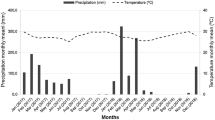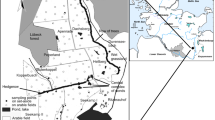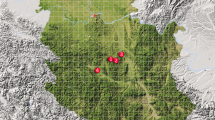Abstract
The community of elaterid larvae of three sites (field and two fallows), representing different stages of secondary succession, were studied using soil sampling from 1986 to 1993. All three sites were abandoned arable land: a field cultivated until 1991, a fallow I abandoned in 1986, and a fallow II abandoned about 1976. The fallow II was used as a meadow after abandonment and was regularly mown until 1985, when cultivation stopped. Six species of Elateridae larvae were found at all three study sites. In the field, Agriotes obscurus, Athous niger, Athous subsuscus, Dalopius marginatus and Athous vittatus were found, A. niger and A. obscurus being the most abundant species. During cultivation, larval densities were very low, however, larval abundance increased up to 8.8 ± 8.3 ind. m-2 when cultivation stopped. Only small A. obscurus larvae were found during cultivation, whereas larval size increased after abandonment. In fallow I A. obscurus, A. niger, A. subsuscus, D. marginatus, and Agrypnus murinus were found and the average annual abundance fluctuated between 0.8 ± 1.4 to 40.8 ± 10.9 ind. m-2 with A. obscurus being the most abundant species. Fallow II supported the highest densities of wireworms from all plots studied (71.2±35.2 to 280.0±24.8 ind. m-2). A. obscurus, A. niger, A. subsuscus and D. marginatus were found in fallow II. The abundance of all larval Elateridae as well as the dominant species A. obscurus decreased during the study period, while simultaneously the occurrence of small sized A. obscurus larvae decreased. The frequency of cultivation and time elapsed since last cultivation appeared to be the most important factors affecting elaterid occurrence in the field and fallow I. In fallow II, the decrease in abundance correlates with the accumulation of a dense litter layer, which may correspond with soil surface structure, plant community changes or predator pressure.
Similar content being viewed by others
References
Frouz J. 1994. Změny společenstev půdních dvoukřídlých (Diptera) v průběhu sekundárná sukcese na opuštěných polích. PhD Thesis, Academy of Sciences of the Czech Republic, České Budějovice, Czech Republic, 199 pp.
Frouz J. 1997. Changes in communities of soil dwelling dipteran larvae during secondary succession in abandoned fields. Eur. J. Soil Biol. 33: 57–65.
Ghilyarov M.S. 1953. Význam půdy jako životního prostředí ve vývoji hmyzu. Přírodov. Vyd., Praha, 310 pp.
Gaston G.R., Bartlett J.H.W., McAllister A.P. & Heard R.W. 1996. Biomass variations of estuarine macrobenthos preserved in ethanol and formalin. Estuaries 19: 674–679
Hemerik L., Gort G. & Brussaard L. 2003. Food preference of wireworms analyzed with multinomial logit models. J. Insect Behavior 16: 647–665.
Cherepanov A.I. 1965. Provoločniky Zapadnoĭ Sibiri. Nauka, Moskva, 190 pp.
Jedlička P. & Frouz J. 1999. Changes in communities of soil dwelling Coleoptera during secondary succession on abandoned fields — a preliminary report, pp. 117–122. In: Tajovský K. & Pižl V. (eds) Soil Zoology in Central Europe, Inst. Soil Biol. AS CR, České Budějovice.
Lefko S.A., Pedigo L.P., Batchelor W.D. & Rice M.E. 1998. Spatial modeling of preferred wireworm (Coleoptera, Elateridae) habitat. Environ. Entomol. 27: 184–190.
Lipský Z. 2000. Sledování změn v kulturní krajině, Lesnická práce, Kostelec n. Č. l., 71 pp.
Masler V. 1982. Škodlivé druhy kováčikovitých na Slovensku a ochrana proti nim. Pol’nohosp. Veda 3: 126.
Mašková Z., Květ J., Zemek F. & Heřman M. 2001. Functioning of mountain meadows under different management impact — research project. Silvia Gabreta 7: 5–14.
Matějka K. 1990. Struktura a funkce rostlinného krytu různých sukcesních stádií se zřetelem k půdní složce ekosystému. PhD Thesis, University of South Bohemia, České Budějovice, Czech Republic, 167 pp.
Meyer E. 1980. IV. Aktivitätsdichte, Abundanz und Biologie der Makrofauna, pp. 1–54. In: Janetschek H. (ed.) Ökologische Untersuchungen an Wirbellosen des zentralalpinen Hochgebirges (Obergurgl, Tirol), Veröffentlichungen der Universität, Innsbruck.
Míchal I. 2002. Divočina jako kulturní objekt, pp. 25–30. In: Tvář naší země — krajina domova, Sborník 5, Ochrana krajiny.
Parker W.E. 2000. Recent developments in wireworm management in the U.K. In: Kornosor S. (ed.), Prooceedings of the XXth Symposium of the IWGO, Adana, Turkey.
Parker W.E., Furlan L. & Tóth M. 2002. Future European priorities for wireworm research. IWGO Newsletter XXIII 1: 18–19.
Parker W.E. & Howard J.J. 2001. The biology and management of wireworms (Agriotes spp.) on potato with particular reference to the U.K. Agric. Forest Entomol. 3: 85–98.
Pižl V. 1992. Succession of earthworms population in abandoned fields. Soil. Biol. Biochem. 24: 1623–1628.
Rotrekl J. 2000. Hodnocení vlivu žíru drátovců (Coleoptera, Elateridae) na vývoj kukuřice a slunečnice z mořeného a nemořeného osiva. Agro 2: 26–28.
Rudolph K. 1974. Beitrag zur Kenntnis der Elateriden larven der Fauna der DDR und BRD (Eine morphologisch-taxonomische Studie). Zool. Jahrb. Abt. Syst. 101: 1–151.
Rusek J. 1967. Kovaříkovití (Elateridae) polních kultur Československa. ČSAV, Praha, 179 pp.
Rusek J. 1972. Die mitteleuropäischen Agriotes-und Ectinus Arten (Coleoptera, Elateridae) mit besonderer Berücksichtigung von A. brevis und den in Feldkulturen lebenden Arten. Rozpravy ČSAV: 1–89.
Sokal R.R. & Rohlf F.J. 1981. Biometry. The Principles and Practice of Statistics in Biological Research. W.H. Freeman & Co., New York, 859 pp.
SPSS, 1999. SPSS users manual 10.0 software, SPSS, Chicago, IL.
Strüve-Kusenberg R. 1981. Sukzesion und trophische Struktur der Bodenfauna von Brachlandflachen. Pedobiologia 21: 132–141.
Tajovský K. 1999. Epigeic activity of millipedes (Diplopoda) in an abandoned field, pp. 351–356. In: Tajovský K. & Pižl V. (eds) Soil Zoology in Central Europe, Inst. Soil Biol. AS CR, České Budějovice.
Ter Braak C.J.F. & Šmilauer P. 1998. Canoco Reference Manual and Users Guide to Canoco for Windows: Software for Canonical Community Ordination (Version 4). Microcomputer Power, Ithaca, NY.
Vernon B. & Päats P. 1997. Distribution of two European wireworms, Agriotes lineatus a A. obscurus in British Columbia. J. Entomol. Soc. Brit. Columbia 94: 59–61.
Vernon B., Lagasa E. & Philip H. 2001. Geographic and temporal distribution of Agriotes obscurus and A. lineatus (Coleoptera: Elateridae) in British Columbia and Washington as determined by pheromone trap surveys. J. Entomol. Soc. Brit. Columbia 98: 257–265.
Author information
Authors and Affiliations
Corresponding author
Rights and permissions
About this article
Cite this article
Jedlička, P., Frouz, J. Population dynamics of wireworms (Coleoptera, Elateridae) in arable land after abandonment. Biologia 62, 103–111 (2007). https://doi.org/10.2478/s11756-007-0017-4
Received:
Accepted:
Issue Date:
DOI: https://doi.org/10.2478/s11756-007-0017-4




